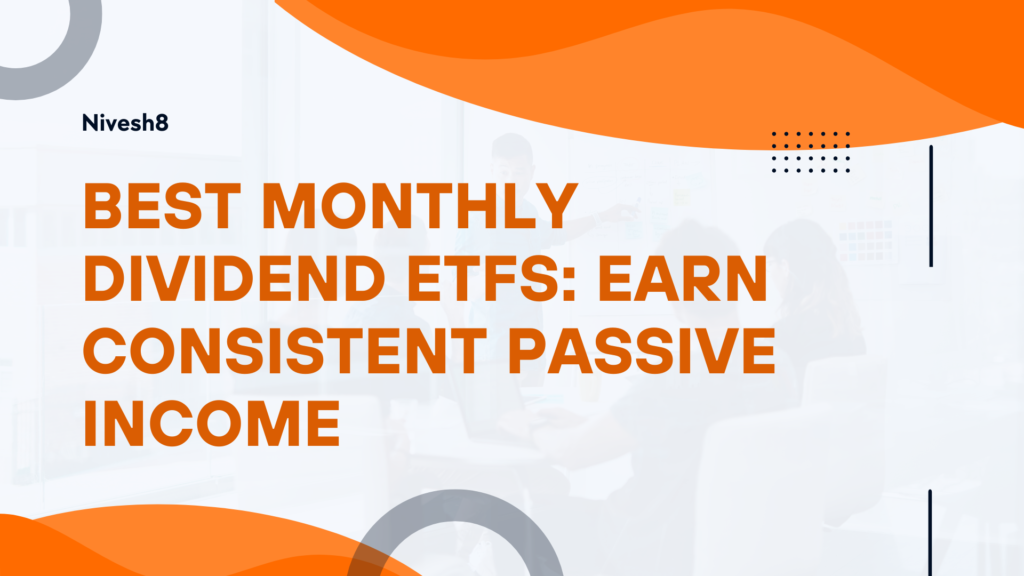One clever approach to create a consistent income source is to invest in best monthly dividend ETFs. Monthly dividend ETFs appeal to income-oriented investors, unlike stocks that pay dividends quarterly or annually, since they pay every month. Selecting the appropriate monthly dividend ETF will help you either build a retirement income source or augment your income.
Why Should One Invest in Monthly Dividend ETFs?
Among the several advantages of investing in the top monthly dividend ETFs are:
- Consistent Cash Flow: Every month, get dividends to cover your expenses.
- Diversification: ETFs often invest in a range of assets, so lowering risk.
- Compounding Growth: Reinvesting dividends can cause notable over-time growth in compound form.
- Lower Expense Ratios: Typically speaking, ETFs have smaller expense ratios than mutual funds.
- Liquidity: ETFs can be bought and sold just as individual stocks allow.
Let us now review some of the best monthly dividend ETFs accessible to help you generate regular income.
Top 5 Monthly Dividend ETFs
Investors should take under consideration some of the most often used and trustworthy best monthly dividend ETFs here:
- Global X SuperDividend ETF (SDIV)
- Dividend Yield: About 13%
- Expense Ratio: 0.59%
- Holdings: World of high-dividend paying corporations
- Why It’s Great:
- High yield and diverse portfolio
- Centers on businesses with consistent dividend payouts
- Appropriate for those with an eye toward income
- High yield and diverse portfolio
- Dividend Yield: About 13%
- Invesco S&P 500 High Dividend Low Volatility ETF (SPHD)
- Dividend Yield: Around 4%
- Expense Ratio: 0.30%
- Holdings: Owns 50 low-volatility, high-dividend S&P 500 stocks
- Why It’s Excellent:
- Emphasizes consistency and consistent income
- Perfect for those who are cautious
- Less volatility than some other dividend ETFs
- Emphasizes consistency and consistent income
- Dividend Yield: Around 4%
- iShares U.S. Preferred Stock ETF (PFF)
- Dividend Yield: Roughly 6%
- Expense Ratio: 0.46%
- Holdings: Selective American company preferred stocks
- Why It’s Great:
- Monthly payouts consistent
- Diversity in utilities and financials
- Fit for those seeking fixed income
- Monthly payouts consistent
- Dividend Yield: Roughly 6%
- Vanguard Real Estate ETF (VNQ)
- Dividend Yield: Roughly 4%
- Expense Ratio: 0.12%
- Holdings: Real estate investment trusts (REITs)
- Why It’s Great:
- Exposure to the real estate industry
- Excellent record of monthly dividend payments
- One low-cost choice among REIT ETFs
- Exposure to the real estate industry
- Dividend Yield: Roughly 4%
- WisdomTree US High Dividend Fund (DHS)
- Dividend Yield: About 3%
- Expense Ratio: 0.38%
- Holdings: U.S. companies with high dividend-paying capacity
- Why It’s Perfect:
- Focuses on dividend sustainability
- Provides consistent pay from quality stocks
- Good combination of consumer basics, financials, and utilities
- Focuses on dividend sustainability
- Dividend Yield: About 3%
How to Select the Best ETF with Monthly Dividends
Choosing the best monthly dividend ETF calls for careful thought of many elements:
- Yield vs. Risk: Higher yields indicate risk even though they mean better monthly income.
- Expense Ratio: Lower fees raise your net returns.
- Strong Holdings: Make sure the ETF boasts strong, dividend-paying companies.
- Performance History: Look for ETFs with a consistent payout record.
- Risk Analysis: Think about the financial situation of the holdings and the consistency of dividends.
Monthly Dividend ETFs have certain advantages, including regular income—ideal for retirees and others requiring consistent cash flow. Use reinvested dividends for living expenses or pay them back off. Some ETFs emphasize low-volatility stocks, providing stability as well as income. Depending on the ETF and jurisdiction, dividends might be eligible for reduced tax rates.
Typical Mistakes to Avoid
Steer clear of these common mistakes while investing in best monthly dividend ETFs:
- Chasing High Yields: Often, very high yields point to dangerous investments.
- Ignoring Expense Ratios: High fees over time can reduce your returns.
- Lack of Diversification: Ignoring portfolio composition increases risk.
- Overlooking Dividend Sustainability: Examine the long-term payout record.
Conclusion
Selecting the best monthly dividend ETF will assist you in creating a consistent income source. Consider options including SDIV, SPHD, PFF, VNQ, and DHS, regardless of whether you seek stability or high yields. Before deciding what to invest in, review your financial objectives, risk tolerance, and the ETF’s general performance. With the correct dividend ETF, start generating regular passive income today!



